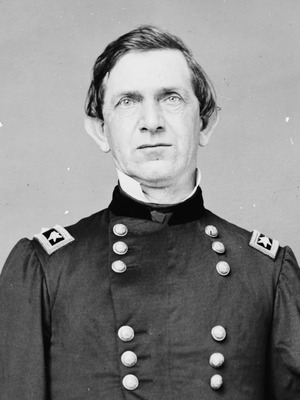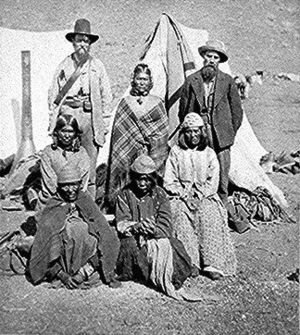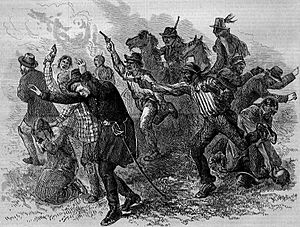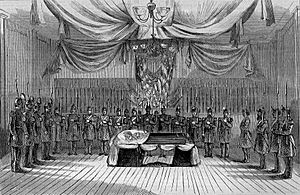Edward Canby facts for kids
Quick facts for kids
Edward R. S. Canby
|
|
|---|---|

Major General E. R. S. Canby in U.S. uniform
|
|
| Born | November 9, 1817 Piatt's Landing, Kentucky |
| Died | April 11, 1873 (aged 55) near Tule Lake, California |
| Place of burial |
Crown Hill Cemetery,
Indianapolis |
| Allegiance | |
| Service/ |
|
| Years of service | 1839–1873 |
| Rank | |
| Commands held | Department of New Mexico Fort Snelling |
| Battles/wars | Indian Wars |
| Signature | |
Edward Richard Sprigg Canby (November 9, 1817 – April 11, 1873) was a United States Army officer and a Union general during the American Civil War. After the war, he served as a military governor.
In 1861–1862, Canby led the Department of New Mexico. He defeated Confederate General Henry Hopkins Sibley at the Battle of Glorieta Pass. This victory forced Sibley to retreat to Texas. Near the end of the war, Canby accepted the surrender of Confederate Generals Richard Taylor and Edmund Kirby Smith.
Canby was known more for his organizing skills than for being an aggressive leader. General Ulysses S. Grant saw him as vital because of his deep knowledge of army rules and laws. In 1873, while commanding the Pacific Northwest, Canby was killed during peace talks with the Modoc. The Modoc were refusing to leave their lands in California. He was the only U.S. general to die during the Indian Wars.
Contents
Early Life and Family
Growing Up and Education
Edward Canby was born in Piatt's Landing, Kentucky, on November 9, 1817. His parents were Israel T. and Elizabeth Canby. He first went to Wabash College. Later, he transferred to the United States Military Academy at West Point. He graduated from West Point in 1839. He became a second lieutenant in the 2nd U.S. Infantry.
While he was often called Edward, some friends knew him as "Richard." At West Point, cadets called him "Sprigg." For most of his career, he was known as E.R.S. Canby.
Marriage and Children
On August 1, 1839, Canby married Louisa Hawkins in Crawfordsville, Indiana. Louisa had three sisters and a brother, and she stayed close to her family. The Canbys had one daughter, but she sadly died when she was young.
Early Military Career
Serving in Early Conflicts
Canby served in the Second Seminole War in Florida. He also fought in the Mexican–American War. During this war, he earned three promotions for his bravery. He became a major for his actions at Contreras and Churubusco. He was promoted to lieutenant colonel for his role at Belén Gates.
After these wars, he worked at various army posts. From 1849 to 1851, he was in the adjutant general's office in California. This was when California was becoming a state.
Work in California
Canby was assigned to be the keeper of the California Archives. This was a civilian job, but he didn't want it. The archives held important records from the Spanish and Mexican governments. They also had mission records and land titles. Canby knew some Spanish, which helped him understand the old land titles.
Service in the West
Canby served in Wyoming and Utah from 1857 to 1858 during the Utah War. During this time, he was on a court-martial panel for Captain Henry Hopkins Sibley. Sibley was found not guilty. Canby later supported a new army tent design that Sibley had created. It was inspired by Native American teepees.
Both officers were later sent to New Mexico. In 1860, Canby led a campaign against the Navajo. He commanded Sibley in an effort to stop Navajo raids on settlers' livestock. The campaign was difficult, and they rarely got close to the Navajo raiders.
Civil War Service
Defending New Mexico
When the American Civil War began, Canby was in charge of Fort Defiance in the New Mexico Territory. On May 14, 1861, he was promoted to colonel of the 19th U.S. Infantry. The next month, he took command of the Department of New Mexico. His former assistant, Sibley, left to join the Confederate Army.
In February 1862, Sibley's Confederate army defeated Canby's troops at the Battle of Valverde. However, Canby eventually forced the Confederates to retreat to Texas. This happened after the Union's important victory at the Battle of Glorieta Pass.
Promotion and Reassignment
After the Battle of Glorieta Pass, Canby was promoted to brigadier general on March 31, 1862. He gathered his forces and chased the retreating Confederates. But he soon stopped the chase and let them reach Texas. Not long after the Confederates failed to invade northern New Mexico, Canby was replaced by General James H. Carleton. Canby was then sent to the eastern United States.
Canby's success in New Mexico came from his smart defensive plan. He and Sibley both had limited supplies. Canby realized that defending the whole territory would spread his troops too thin. He knew Sibley had to attack along a river, especially during a long drought. So, Canby focused his defenses on two possible attack routes: along the Rio Grande or by way of the Pecos and Canadian rivers. He could move his forces to protect Fort Union if needed. Canby also convinced the governors of New Mexico and Colorado to raise volunteer soldiers. These Colorado troops were very helpful at both Valverde and Glorieta.
Later War Assignments
After some office work, Canby was put in charge of New York City on July 17, 1863. This was after the New York Draft Riots, which caused many deaths and damage. He worked there until November 9, helping to restart the draft. He also oversaw a prisoner of war camp in New York Harbor.
In May 1864, Canby was promoted to major general. He took over command from Nathaniel P. Banks in Simmesport, Louisiana. Next, he commanded the Military Division of Western Mississippi. On November 6, 1864, he was wounded in his upper leg by a guerrilla while on a gunboat in Arkansas.
Canby led the Union forces that attacked Mobile, Alabama, in the spring of 1865. This led to the Battle of Fort Blakeley and Mobile's fall on April 12, 1865. Canby accepted the surrender of Confederate forces under General Richard Taylor on May 4, 1865. He also accepted the surrender of General Edmund Kirby Smith's forces west of the Mississippi River on May 26, 1865.
Canby was seen as a great organizer, but some criticized his military leadership. General Ulysses S. Grant thought he wasn't aggressive enough. Grant once told Canby to "destroy [the enemy's] railroads, machine-shops, &c." Ten days later, Grant was annoyed when Canby asked for materials to *build* railroads. Grant said, "I wrote... urging you to... destroy railroads, machine-shops, &c., not to build them." Canby could destroy, but he seemed to prefer building.
If anyone had questions about army rules or Constitutional law related to the military, Canby was the person to ask. Grant valued this in peacetime. He once complained when President Andrew Johnson wanted to move Canby away from the capital. Grant believed Canby was irreplaceable there.
Canby's father had once owned slaves. Some of Canby's cousins fought for the Confederacy. One cousin was captured. His father asked Canby to use his influence to free his son. But Canby refused, saying he shouldn't use his position to help family. Later, when Canby was a military governor, he also refused to favor relatives who were trying to profit from the South's rebuilding.
Helping Formerly Enslaved People
In April 1869, General Canby became the military governor of Virginia. He soon realized that thousands of formerly enslaved Black people needed medical and economic help. Canby had to figure out how to provide health services for them.
He decided that Virginia should build a separate hospital for Black people with mental health needs. This was called the Central Lunatic Asylum for Colored Insane. It was the first facility of its kind in the United States. Canby's order helped create this hospital. It remained segregated by race until the Civil Rights Act of 1964.
Post-War Assignments
After the war, Canby commanded several military departments during the Reconstruction Era. This was a time when the government was trying to manage big social changes and keep peace. He commanded Louisiana from 1864 to May 1866. Then he was in charge of the Department of Washington. This included Delaware, Maryland, District of Columbia, and parts of Virginia.
In August 1867, he was assigned to the Second Military District, which covered North and South Carolina. In August 1868, he briefly returned to command in Washington.
In November, he was assigned to the Fifth Military District in Texas. He focused on rebuilding Texas. In April 1869, he moved to Virginia, the First Military District, serving there until July 1870. These jobs put Canby in the middle of conflicts. These included fights between political parties, white and Black people, and state and federal governments. New state laws were being written, and the social situation was very tense. There were attacks against freed people and Republicans. Canby sometimes upset both sides, but he was seen as fair and honest.
Final Assignment and Death
The Modoc War
In August 1872, Canby was sent to command the Pacific Northwest. He soon faced problems with the Modoc tribe. The Modoc had lived in Northern California for a long time. They were forced to move to a reservation in Oregon. They had to share it with their enemies, the Klamath tribe. The Modoc asked the U.S. government to let them return to California, but they were refused. So, the Modoc left the reservation and went back illegally.
In 1872, the U.S. Army tried to force them back, and the Modoc War began. The Modoc dug in at Captain Jack's Stronghold near Tule Lake. They fought off army attacks and held their ground.
General Canby received mixed orders from Washington. He wasn't sure whether to make peace or continue the war. Since the war wasn't working, the U.S. government created a peace commission. Canby was given a key role on this commission.
There were many talks between the Modoc and the white settlers. At one point, someone told Captain Jack, the Modoc leader, that the governor of Oregon planned to hang nine Modoc if they surrendered. The Modoc then stopped the scheduled talks. Canby was angry about the rumors. He believed his federal authority was stronger than the governor's threat. Canby had no intention of letting the Modoc be punished without a fair trial.
Peace Talks and Assassination
On April 11, 1873, after many failed meetings, Canby went to another peace talk. He was unarmed and hoped for a final agreement. Judge Elijah Steele warned Canby that the Modoc were unpredictable and he was in danger. Canby replied, "I believe you are right, Mr. Steele, and I shall regard your advice, but it would not be very well for the general in command to be afraid to go where the peace commissioners would venture."
The peace talks took place between the army camp and Captain Jack's stronghold near Tule Lake. It was later found that two members of Canby's group had hidden weapons. Modoc warriors were also armed.
According to Jeff C. Riddle, the Modoc son of the U.S. interpreter, the Modoc had planned to kill Canby and the other commissioners before the meeting. They believed peace was not possible and were determined to "fight until we die." Captain Jack attacked the general. With Ellen's Man, one of his lieutenants, he shot Canby. Canby died from his wounds.
Aftermath
Canby's death caused great anger across the nation against the Modoc. Eventually, Captain Jack (Kintpuash), Boston Charley, Schonchin John, and Black Jim were tried for murder. They were found guilty and executed on October 3, 1873. The remaining Modoc people were sent to reservations.
The killing of Canby, along with the Great Sioux War, made people lose faith in President Grant's peace policy. Many people felt that Native Americans should be fully defeated.
After memorial services on the West Coast, Canby's body was returned to Indiana. He was buried in Crown Hill Cemetery, Indianapolis, Indiana, on May 23, 1873. Four Union generals attended his funeral: William Tecumseh Sherman, Philip Sheridan, Lew Wallace, and Irvin McDowell. The last two were among the pall bearers. A reporter noted that during the funeral procession, there were "expressions of hatred toward the Modoc."
Legacy and Honors
- 1871: He received an honorary degree from Wesleyan University in Middletown, Connecticut.
- 1875: Fort Canby, a coastal defense base at the mouth of the Columbia River, was named in his honor.
- 1880s: Canby's Cross was built in his honor near where the peace talks happened. This area is now part of the Lava Beds National Monument.
- The towns of Canby in Clackamas County, Oregon, Canby in Yellow Medicine County, Minnesota, and Canby in Modoc County, California, are named after him.
- Canby, Oregon's annual July 4th celebration used to be called General Canby Days. It included a pancake breakfast, car show, parade, and music.
Cultural Depictions
- The 1954 Western movie Drum Beat showed the 1873 Modoc War and Canby's death. Warner Anderson played Canby, and Charles Bronson played Captain Jack.
- Colonel Canby is mentioned in the 1966 movie "The Good, the Bad and the Ugly" as a Confederate group retreats through a town.





